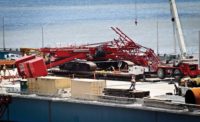
The failure of bolts anchoring suspender rods likely sent tons of precast concrete ceiling panels crashing onto the roadway in a tunnel in central Japan on Dec. 2. Officials of the Central Nippon Expressway Co. have identified the bolts as the possible weak link in the ceiling support system in the Sasago Tunnel, about 50 miles west of Tokyo on the main highway connecting the capital with central Japan.
Nine people died and two were injured in the accident, which occurred at around 8 a.m. Opened to traffic in 1977, the three-mile-long tunnel carries two lanes of eastbound traffic. An adjacent twin tunnel carries two lanes westbound.
The tunnel was excavated using conventional techniques, Taro Hashimoto, an engineer and spokesman for the expressway company, told ENR in a telephone interview. The tunnel has a horseshoe cross-section roughly 32 feet across at its widest. In what Hashimoto says was a very typical design at the time, the ceiling separates ventilation spaces from the traffic lanes, with a concrete panel wall separating the fresh-air and exhaust sections. The ceiling was formed of precast concrete planks 16 ft long, 4 ft wide and 3 in. thick. Each weighs about 1.5 tons. The planks span about 15 ft from the tunnel sides to a central hanging support system, where they rest on an inverted T-shaped steel member.
Steel rods spaced at 4 ft connect the T to a continuous bracket, bolted to the tunnel crown's concrete lining. The 0.6-in.-dia bolts extend 5 in. into the concrete. The bolts apparently failed along a 400-ft tunnel section, dumping several hundred ceiling and wall panels onto the roadway and crushing three vehicles. One vehicle burst into flames, producing smoke that hampered initial rescue efforts. "We don't yet know exactly how [the hanger assembly] fell, whether it was corrosion or something else, we're just beginning the investigation," says Hashimoto.
At a press conference on Dec. 3, expressway company officials said there have not been any major repairs to the structure since it opened. The tunnel had been inspected in September, when connections were checked visually without any tapping or physical testing, they added.
Also on Dec. 3, Japan's Ministry of Land, Infrastructure and Transport ordered emergency inspections of 49 highway tunnels of similar design. It also formed a panel of experts to determine the cause of the Sasago disaster and make recommendations to prevent similar accidents. The experts visited the tunnel on the afternoon of Dec. 4.
Separately, NHK, Japan's national public broadcaster, reported that prefectural police were gathering evidence of possible professional negligence by the expressway company.


Post a comment to this article
Report Abusive Comment